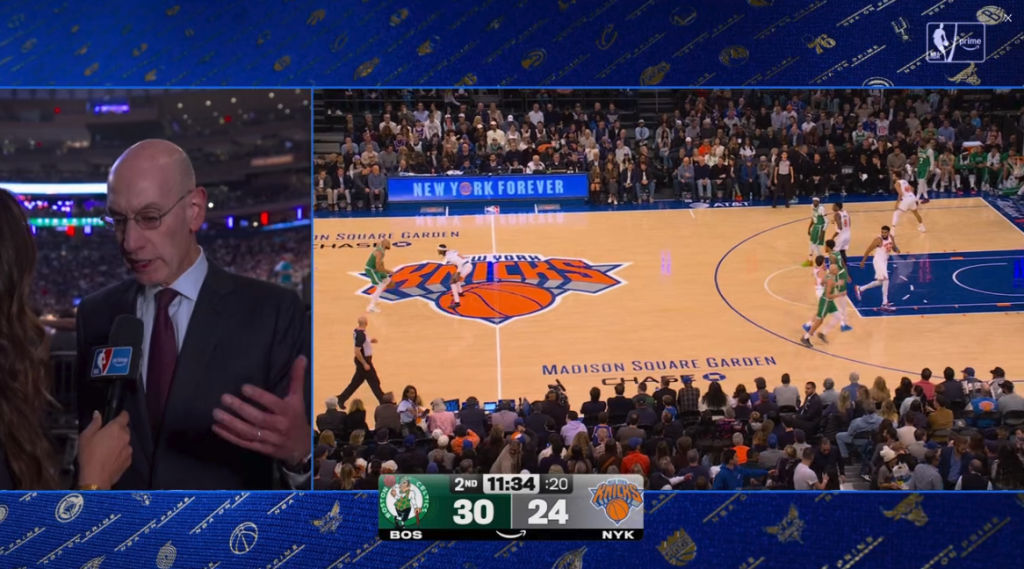Amazon’s NBA Debut: A New Era for Sports Broadcasting
In a landmark moment for digital sports broadcasting, Amazon Prime Video launched its first-ever live NBA game on Friday, marking a significant evolution in how fans experience professional basketball. “It is here, it is real, it is happening,” announced play-by-play commentator Ian Eagle as the broadcast began. “The NBA on Prime.” This debut wasn’t just another game—it represented the beginning of Amazon’s ambitious 11-year partnership with the NBA, granting the tech giant exclusive rights to select regular season and playoff matchups, starting with the Celtics-Knicks showdown that showcased what may become the new standard for sports viewing experiences.
The technical execution of Amazon’s first NBA broadcast demonstrated the company’s readiness for prime time sports coverage. Viewers across multiple platforms—Fire TV devices, iPhones, and laptops—experienced a seamless high-definition stream with 1080p HDR video and 5.1 surround sound that rivaled or exceeded traditional television broadcasts. There was virtually no buffering or lag on stable internet connections, with near-instant load times creating an uninterrupted viewing experience. While incorporating technological innovation, Amazon wisely maintained the familiar feel of a traditional national telecast, featuring recognizable commentary from Ian Eagle and Stan Van Gundy, alongside professional graphics packages similar to what basketball fans have come to expect from established networks like ESPN and TNT. The pre-game show, broadcast from Amazon MGM Studios, featured a sleek set complete with an LED court that allowed basketball legends like Steve Nash, Dirk Nowitzki, Blake Griffin, and Udonis Haslem to visually demonstrate game dynamics for viewers.
Perhaps the most notable innovation in Amazon’s NBA coverage was its subtle yet significant integration of sports betting features—particularly timely given the context of a major NBA betting scandal making headlines that same week. For viewers watching on Fire TV, Amazon introduced a FanDuel integration that allowed users to log into their betting accounts directly through Prime Video, enabling them to view real-time betting information and track wagers without leaving the broadcast. While the platform doesn’t yet allow viewers to place bets directly through the stream, this integration clearly signals where sports broadcasting might be heading. The juxtaposition became even more striking when NBA Commissioner Adam Silver joined the broadcast for a live interview, where sideline reporter Cassidy Hubbarth immediately addressed the ongoing betting scandal. Silver acknowledged being “deeply disturbed” by the news, emphasizing that “there’s nothing more important to the league and its fans than the integrity of the competition.” The commissioner even noted the irony of the moment: “I guess I wouldn’t have predicted that my first interview on Amazon would be about sports betting,” highlighting the complex relationship between sports, technology, and gambling that’s rapidly evolving.
Amazon’s broader strategy for sports broadcasting is becoming increasingly clear: leverage live sports content to drive Prime memberships and enhance engagement across its vast ecosystem. The NBA games, prominently featured on Amazon’s homepage and apps, serve as powerful content magnets to attract and retain subscribers to the $139/year Prime service. According to Bloomberg, Amazon is investing approximately $1.8 billion annually for these NBA rights—a significant commitment that reflects the company’s belief in live sports as a cornerstone of its content strategy. This approach aligns with broader industry trends as streaming platforms compete for valuable sports rights in an era where traditional cable subscriptions continue to decline. Major tech companies including Amazon, Apple, and Netflix are increasingly positioning themselves as the future homes of live sports broadcasting, offering leagues new distribution channels as their traditional television deals expire.
With this NBA partnership, Amazon continues expanding its impressive sports portfolio, which already includes NFL Thursday Night Football, WNBA games, and international soccer coverage like the Premier League. For the 2025-26 NBA season alone, Amazon will stream 66 regular season games plus select playoff matchups, giving basketball fans plenty of reasons to maintain their Prime subscriptions. What sets Amazon’s approach apart from traditional broadcasters is its ability to layer technology-driven features on top of familiar sports viewing experiences. Beyond the betting integration, Amazon is developing advanced NBA statistics powered by AWS, though these features weren’t prominently featured in the initial broadcast. The only notable weakness appeared in the Fire TV user interface, which some viewers found less intuitive than mobile or desktop experiences, with awkward remote button mapping that occasionally complicated navigation.
The successful NBA debut demonstrates Amazon’s unique position at the intersection of entertainment, technology, and commerce. While delivering the reliability expected of traditional sports broadcasts, the company simultaneously introduced subtle technological enhancements built on its cloud infrastructure and unified by the Prime membership model. This approach represents both the culmination of Amazon’s sports strategy to date and a glimpse into broadcasting’s future. As the boundaries between traditional television and streaming continue to blur, Amazon is positioning itself not just as a distributor of sports content but as an innovator reimagining how fans engage with their favorite games. With the NBA now joining its expanding sports lineup, Amazon has solidified its place as a major player in the evolving media landscape—one that combines the familiar comforts of traditional sports viewing with the technological possibilities that only a tech giant can deliver. For basketball fans, this means more viewing options and innovative features; for the sports broadcasting industry, it signals that the digital transformation is accelerating faster than many anticipated.


